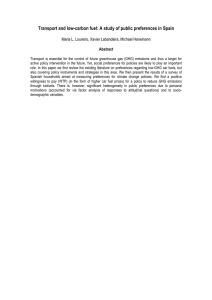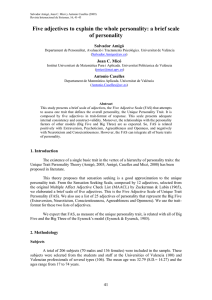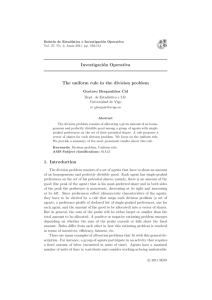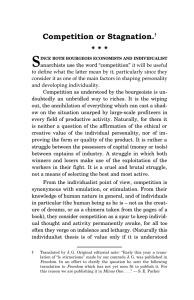are the patient preferences for communication related with
Anuncio
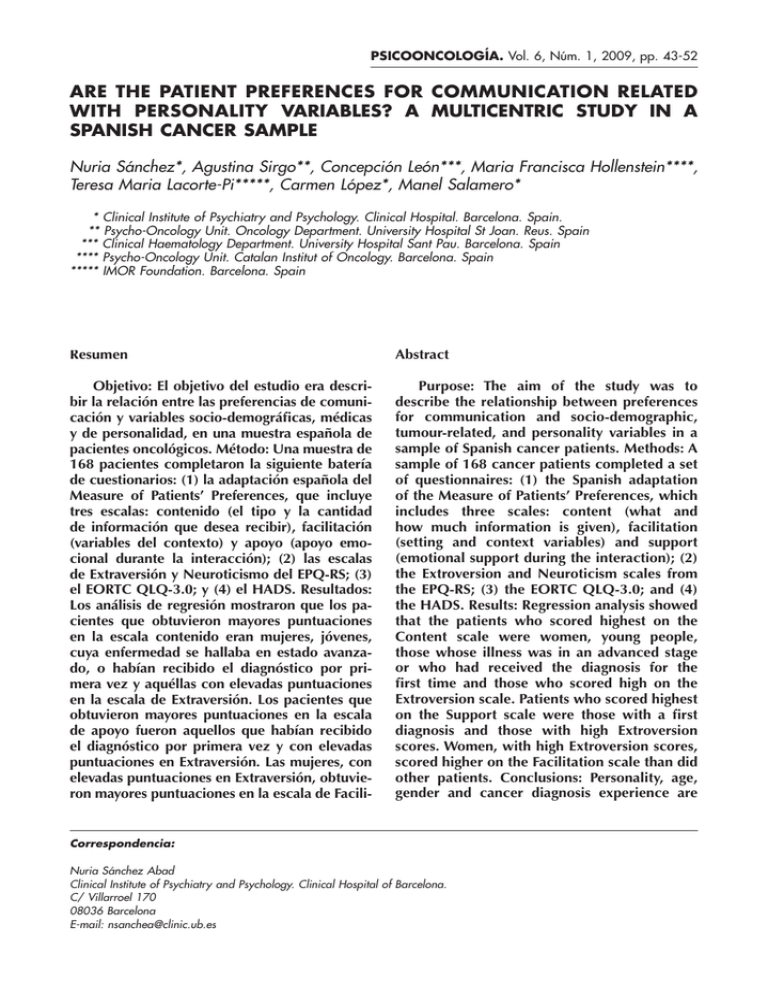
PSICOONCOLOGÍA. Vol. 6, Núm. 1, 2009, pp. 43-52 ARE THE PATIENT PREFERENCES FOR COMMUNICATION RELATED WITH PERSONALITY VARIABLES? A MULTICENTRIC STUDY IN A SPANISH CANCER SAMPLE Nuria Sánchez*, Agustina Sirgo**, Concepción León***, Maria Francisca Hollenstein****, Teresa Maria Lacorte-Pi*****, Carmen López*, Manel Salamero* * Clinical Institute of Psychiatry and Psychology. Clinical Hospital. Barcelona. Spain. ** Psycho-Oncology Unit. Oncology Department. University Hospital St Joan. Reus. Spain *** Clinical Haematology Department. University Hospital Sant Pau. Barcelona. Spain **** Psycho-Oncology Unit. Catalan Institut of Oncology. Barcelona. Spain ***** IMOR Foundation. Barcelona. Spain Resumen Abstract Objetivo: El objetivo del estudio era describir la relación entre las preferencias de comunicación y variables socio-demográficas, médicas y de personalidad, en una muestra española de pacientes oncológicos. Método: Una muestra de 168 pacientes completaron la siguiente batería de cuestionarios: (1) la adaptación española del Measure of Patients’ Preferences, que incluye tres escalas: contenido (el tipo y la cantidad de información que desea recibir), facilitación (variables del contexto) y apoyo (apoyo emocional durante la interacción); (2) las escalas de Extraversión y Neuroticismo del EPQ-RS; (3) el EORTC QLQ-3.0; y (4) el HADS. Resultados: Los análisis de regresión mostraron que los pacientes que obtuvieron mayores puntuaciones en la escala contenido eran mujeres, jóvenes, cuya enfermedad se hallaba en estado avanzado, o habían recibido el diagnóstico por primera vez y aquéllas con elevadas puntuaciones en la escala de Extraversión. Los pacientes que obtuvieron mayores puntuaciones en la escala de apoyo fueron aquellos que habían recibido el diagnóstico por primera vez y con elevadas puntuaciones en Extraversión. Las mujeres, con elevadas puntuaciones en Extraversión, obtuvieron mayores puntuaciones en la escala de Facili- Purpose: The aim of the study was to describe the relationship between preferences for communication and socio-demographic, tumour-related, and personality variables in a sample of Spanish cancer patients. Methods: A sample of 168 cancer patients completed a set of questionnaires: (1) the Spanish adaptation of the Measure of Patients’ Preferences, which includes three scales: content (what and how much information is given), facilitation (setting and context variables) and support (emotional support during the interaction); (2) the Extroversion and Neuroticism scales from the EPQ-RS; (3) the EORTC QLQ-3.0; and (4) the HADS. Results: Regression analysis showed that the patients who scored highest on the Content scale were women, young people, those whose illness was in an advanced stage or who had received the diagnosis for the first time and those who scored high on the Extroversion scale. Patients who scored highest on the Support scale were those with a first diagnosis and those with high Extroversion scores. Women, with high Extroversion scores, scored higher on the Facilitation scale than did other patients. Conclusions: Personality, age, gender and cancer diagnosis experience are Correspondencia: Nuria Sánchez Abad Clinical Institute of Psychiatry and Psychology. Clinical Hospital of Barcelona. C/ Villarroel 170 08036 Barcelona E-mail: [email protected] 44 Nuria Sánchez et al. tación que el resto de pacientes. Conclusiones: La personalidad, edad, género y el estadío de la enfermedad son variables importantes a tener en cuenta en los estudios sobre comunicación médico-paciente. Palabras clave: Personalidad, preferencias del paciente, malas noticias, relación médico-paciente. INTRODUCTION As most of the work in clinical medicine takes place in an interpersonal context, information and communication skills are essential in order to provide quality interventions. The doctor-patient relationship is particularly important in the case of life-threatening diseases such as cancer. Breaking bad news about a diagnosis, relapse or the shift from curative to palliative treatment is an especially difficult task. Indeed, the oncologist has to impart complex medical information concerning the diagnosis, treatment options and possible side effects in what for patients and their relatives is an emotionally-charged context. Therefore, the communication between oncologists and cancer patients has been an important area of research over the last decade. Studies with this patient group have shown that higher levels of satisfaction with the information given are associated with improved compliance with medical advice, better understanding of the information given, greater treatment adherence, and improved psychological adaptation(1-5). The important benefits of communication skills in clinical practice has led to the development of guides dealing with how to break bad news, as well as to numerous training initiatives for medical professionals(6-8). These efforts are consistent with the ethical important variables to take into account when conducting studies of doctor-cancer patient communication. Key words: Personality, patient preferences, bad news, doctor-patient relationship. values and statutes that promote the principle of patient autonomy, that is, the patient’s right to be informed about and involved in the medical decisionmaking process. However, these guides have been developed on the basis of the clinical opinion of medical professionals rather than being based on data derived from patients themselves. Indeed, most studies of doctor-patient communication have focused on the influence of the doctor’s communication skills, whereas patients’ preferences for communication in the clinical setting have received less attention. Identifying the variables related to the preferences for communication of cancer patients would enable general recommendations to be adapted to their particular needs. Studies in this area have focused especially on sociodemographic and medical variables. The literature shows that younger patients prefer to receive more detailed information about their illness(9) and to take a more active role in medical decisions(10). In contrast, older patients feel more satisfied with a doctor-led communication style, where the doctor decides how much information to give and which the best treatment option is(11). Women show a greater need than men both for information about diagnosis and treatment(12) and for emotional support from health professionals(9). Educational level has also been found to be directly Are the patient preferences for communication related with personality variables? var A multicentric ... related to the need for information about different aspects of illness(10). In terms of medical variables, some studies report that patients whose illness is in an advanced stage prefer to be given less detailed information(13). Others, however, reveal that the need for information can vary during the disease process; patients whose condition has recently worsened prefer to be progressively less involved in medical decision-making(12). Published results suggest that both socio-demographic and medical variables are important in terms of the way patients prefer to be informed. However, there have been no studies of how patients’ personality influences their preferences for communication in the medical context. Personality characteristics may affect both the way patients perceive the information given them about their illness and their ability to cope with it, and this could produce differences in terms of communication preferences and the need for support. Indeed, the way in which people deal with difficult situations, such as the diagnosis and treatment of a serious illness, has consistently been related to basic personality traits. Specifically, people with high scores on Neuroticism tend to show high levels of anxiety in the face of stress. In terms of strategies for coping with stress, research has shown there to be a close relationship between Neuroticism and an avoidant and inflexible coping style. This coping style is associated with a greater risk of developing psychopathological disorders during an illness. Extroversion, however, has been linked to both an active coping style, geared toward problem solving, and to a greater tendency to seek social support (14, 15). Some studies have reported a relationship between coping styles and preferences for information. Miller(16) studied individual differences with 45 respect to seeking information in the face of stressful events. She developed the construct of monitoring/blunting to describe the way in which people respond cognitively and emotionally to potentially stressful information. The coping style termed monitoring refers to the tendency to seek information actively when faced with a stressful situation, as opposed to blunting which refers to those people who tend to avoid stressful information. Steptoe et al.(17) found that patients who tended to avoid information (‘blunters’) were more satisfied with the information received. In a study carried out with cancer patients Ong et al.(18) reported that the monitoring style was related to the preference for more detailed information and greater involvement in medical decisions. Coping styles with respect to information were not related with other personal or medical variables. Despite the above, there is very little published research on the relationship between personality traits and communication in the medical context. Some studies show that personality may affect the patient’s communication style and, as a consequence, medical decisions. Ellington and Wiebe(19) found that Neuroticism was associated with more elaborate symptom presentations and with more allusions to psychosocial information. These features created more doubts about the seriousness of the illness, and thus, when faced with patients with high Neuroticism scores, doctors tended to make more therapeutically-conservative decisions. The anxiety trait has also been shown to be related to preferences regarding the communication style of doctors. People with high trait anxiety feel more satisfied with a more physician-led communication style, as opposed to those with low trait anxiety who prefer a more patientcentred approach(20). 46 Nuria Sánchez et al. These findings suggest that personality may be a relevant variable in studies of preferences in doctor-patient interaction. In terms of the diagnosis and treatment of cancer, personality traits may predict differences with respect to the kind of medical information that patients wish to receive, as well as their need for support from health professionals during their illness. The present study aimed to analyse, in a sample of cancer patients, the possible relationship between basic personality traits and preferences for information about illness, emotional support and the context in which information is given, controlling for the effect of socio-demographic, medical and psychopathological variables. METHOD Sample The definitive sample comprised 168 adult cancer patients who were receiving treatment at different centres in Catalonia, and who volunteered to take part in the study. Any patients with severe psychiatric disorder or organic mental disorder, as well as those unable to read and write, were excluded from the study. Procedure Patients were informed about the objectives of the study and assessed after signing an informed consent form. The researchers requested socio-demographic data (age, sex, educational level and employment status) directly from the participants, while medical data (diagnosis, time since diagnosis, diagnosis experience, current type of treatment, evolution of illness, treatment regime and psychopathological history) were gathered from the patients’ medical records. The following battery of questionnaires was administered to participants during a single session: 1) Measure of Patients’ Preferences (MPP)(9). This comprises 32 items that assess the preferences of cancer patients with respect to different aspects of communication in the oncology context. The items are distributed across three scales: 1) Content, which refers to the amount of detail that patients wish to be given about their diagnosis and treatment for cancer; 2) Support, which concerns the need for social support from health professionals; and 3) Facilitation, which includes items about contextual variables that facilitate communication. Each item is scored on a five-point Likert scale and patients have to respond according to how important a given item is to them, higher scores being indicative of greater importance. The Spanish adaptation of the questionnaire(21) reported α coefficients of 0.91 for the Content scale, 0.90 for the Support scale and 0.70 for the Facilitation scale. 2) The Spanish form(22) of EPQ-RSShort For(23). This is a revised and short form of the EPQ that measures basic personality traits (Neuroticism, Extroversion and Psychoticism). Each sub-scale contains 12 dichotomous response (yes/ no) items. In the present study only the Neuroticism and Extroversion scales were administered. 3) HADS(24). A 14-item scale designed to detect clinically significant levels of anxiety and depression in out-patients. According to the Spanish validation(25) the cut-off point is 4-7 for the depression scale and 7-10 for the anxiety scale. 4) EORTC-QLQ-C3.0(26). A questionnaire of 30 items grouped into five functional dimensions (physical, role, social, emotional and cognitive functioning), three symptom dimensions (pain, fatigue, nausea and vomiting), and an overall qual- Are the patient preferences for communication related with personality variables? var A multicentric ... 47 Table 1. Demographic and medical characteristics (N=168) ity-of-life dimension; there are also individual items related to symptoms of the illness and treatment. A high score on the functional scales indicates a better quality of life, while a high score on the symptom scales indicates the opposite. For the present analysis we only considered the overall functional scale (mean of the scores on the five functional dimensions) and the overall symptom scale (mean of the scores on the three symptom dimensions). The questionnaire has been validated in a Spanish population(27). Sex Female Male 65.5 34.5 Marital status Married/living with partner Never married/Divorced/Widowed 66.1 33.9 Statistical Analysis Education <=8 years > 8years 41.1 58.9 Employed Yes No 42.9 57.1 Cancer recurrence No Yes 80.5 19.5 Type of cancer Breast Haematological Prostate Others 37.5 16.7 16.7 29.2 Metastases No Yes 83.3 16.7 Psychopathological antecedents Yes No 30.9 69.1 Statistical analysis was carried out using SPSS 10.0. In order to test the relationship between personality variables and preferences for communication, independent of other possible confounding factors, we conducted a hierarchical multiple regression for each of the MPP scales (Content, Support and Facilitation). The possible effect of confounding variables was controlled for by introducing them at the start of the analysis. In the first block (confounders) we included four categories of variable: socio-demographic (sex, age, educational level, employment status and marital status), medical (time since diagnosis, type of cancer, evolution of illness, treatment regime and psychopathological history), quality of life (physical functioning scale and functional level scale from the EORTC), and emotional state (HADS). We then introduced the personality variables (Neuroticism and Extroversion) in the second block. RESULTS Descriptive The sample characteristics are summarised in Table 1. % patients The definitive sample comprised 168 patients. The mean age was 52.58 years, and the majority were women (65.5%). Patients had been given a diagnosis of cancer between one month and three years previous (mean=21.5 months; 48 Nuria Sánchez et al. SD=39.12), and for the majority this was the first time the illness had been diagnosed (80.5%). 37% of patients presented significant levels of depressive symptomatology, while 27% showed symptoms of anxiety. The mean score on the functional scale of the EORTC was 67.25 (21.32), and that on the symptom scale 22.25 (16.63). Relationship between preferences for communication and personality variables Content Scale The regression analysis for the Content scale (R=.65) revealed six significant variables: constant, sex, age, prostate cancer, evolution of illness, diagnosis experience and extroversion. The model obtained accounted for 64.6% of the variance (see Table 2). Women preferred to receive more detailed information about their illness than did men. Age was inversely related to the need for information: the older the patient the less importance was attached to the content of illness-related information. Patients with a diagnosis of prostate cancer obtained significantly lower scores on the Content scale as compared with patients with other types of neoplasm. Patients with advanced cancer and those who had been given a diagnosis for the first time attached more importance to receiving detailed information. Marital status, educational level, employment status, time since diagnosis, the treatment regime, psychopathological history, quality of life and emotional state were not related to preferences regarding the content of medical information. Scores on Extroversion were shown to be directly related to content preferences: the more extrovert patients wished to receive more detailed information about their illness. Neuroticism, however, did not prove to be a relevant variable. Support Scale The regression analysis for the Support scale revealed three variables (R=.52): constant, prostate cancer, diagnosis experience and extroversion. Patients with prostate cancer attached less importance to receiving emotional support from health professionals during medical visits than did patients with other types of neoplasm. People who had received the diagnosis for the first time showed a greater need for support than did those who had suffered a relapse of their illness. The remaining variables were excluded from the analysis. Patients with higher scores on Extroversion showed a greater need for support from health professionals. No relationship was found between Neuroticism and the Support scale. Facilitation Scale The regression analysis for the Facilitation scale revealed three variables (R=.44): constant, sex, prostate cancer and extroversion. Women attached more importance to aspects of the context in which the doctor-patient interaction took place. Patients with prostate cancer showed less preference for contextual variables than did the other patients. Extroverted people obtained higher scores on the Facilitation scale, and as before Neuroticism proved not to be a predictive variable with respect to preferences for contextual aspects. DISCUSSION The present study has identified socio-demographic, medical and personality variables related to the way in which cancer patients prefer to be informed about their illness. Are the patient preferences for communication related with personality variables? var A multicentric ... 49 Table 2. Standardized Regression Coefficients from Regression Analyses of Demographic, Medical and Personality variables on the Measure Patients’ Preferences Subescales. β Coefficients p CONTENT (R=.625) (Constant) .000 Sex .247 .005 Age -.145 .054 Prostate -.215 .028 Metastases .264 .000 Recurrence -.179 .013 Extraversion .246 .001 SUPPORT (R=.503) (Constant) .000 Prostate -.391 .000 Recurrence -.189 .013 Extraversion .216 .008 FACILITATION (R=.439) (Constant) Sex Prostate Extraversion .000 .222 .028 -.157 .136 .175 .040 NOTE. β coefficients represent the correlation of the predictor variables with the subscale score adjusting for the other variables in the model. 50 Nuria Sánchez et al. Our results suggest that both sex and age are relevant variables in the preferences for communication of cancer patients: women and young patients showed a preference for more detailed information about their illness. Previous studies have reported that women as a group more often seek healthrelated information than do men(28). The predictive value of prostate cancer in the three aspects of communication (content, support and context) may be masking the interaction of two variables: age and sex. In addition to being men, the patients with prostate cancer had a significantly greater mean age than the other patients. Thus, we could conclude that young women prefer to receive more detailed information about their illness and treatment, and attach more importance to the support offered by doctors and the suitability of the context in which information is given. These results are consistent with those of previous studies of preferences for communication among cancer patients(11, 12) . In contrast to previous reports(9), however, educational level was not related to information preferences. In terms of medical variables, the illness stage and diagnosis experience were significantly related to preferences regarding the content of communication. Patients who had been diagnosed for the first time showed a greater need for both information and emotional support than did patients being treated for a relapse of their illness. Patients with advanced cancer presented a greater need for detailed information about the evolution of their illness. These results do not coincide with those reported by Fallowfield(13), whereby those patients who preferred to receive less detailed information were mostly those with the worst prognosis. Whatever the case, it is difficult to interpret the explanatory value of medical variables related to prognosis when the information which patients have in this regard is not controlled for. Quality of life and emotional state did not influence the needs of patients for information or support. The most novel finding of the present study was the close relationship between personality and patients’ scores regarding their communication preferences. Extroversion consistently predicted the scores obtained on the three scales. Thus, people with high Extroversion scores preferred to receive more detailed information about medical aspects, showed a need for support from health professionals, and attached greater importance to the context in which information was given. These results are consistent with the literature concerning the relationship between personality and coping with stress. Extrovert people tend to use active strategies in dealing with stress, that is, they need to seek more information and emotional support. The way in which stress is dealt with in general may be consistent with people’s approach to illness-related information. Thus, with respect to the diagnosis and treatment of cancer, our results illustrate that extrovert patients also show a greater need for information and emotional support from the health professionals who care for them. In contrast, Neuroticism was not related to patients’ preferences for communication. These results suggest that when oncologists communicate information to patients it is important that they consider not only socio-demographic and medical factors but also personality variables. Our study shows that the patients who prefer to receive more detailed information were women, young people, those who hade been diagnosed for the first time, and those with high scores on Extroversion. The patients who attached more Are the patient preferences for communication related with personality variables? var A multicentric ... importance to the emotional support offered during medical visits were those who had received the diagnosis for the first time and those who were more extroverted. Finally, extrovert women attached more importance to aspects of the context in which the doctor-patient interaction takes place. Our study was carried out with a wide sample of patients with different types of cancer and who were being treated in different centres in Catalonia. Therefore, we believe the sample to be representative of this population. However, the proportion of women was much greater than that of men, and furthermore, there was a significant difference between the age of the male and female sub-samples. This may have influenced the results regarding the relationship between age and sex and preferences for communication. Nevertheless, the results concerning age and sex are comparable with those obtained in other studies. Another limitation is that the communication preferences were only assessed on one occasion. The crosssectional design is unable to tell us whether personality characteristics would predict the need for information and social support in the same way across the whole disease process. In our study, time since diagnosis was not a relevant variable with respect to the communication needs of patients. Further prospective studies are needed to evaluate the stability of the influence of personality on the way in which patients wish to be informed about their illness at different points of its evolution. Moreover, given that there is evidence to suggest that patients who need more information tend to be less satisfied with the information received(16), it would be interesting to study the extent to which personality is related to satisfaction with communication in the 51 oncology context. It is also necessary to replicate our results in patients from other countries in order to see whether the relationship between extroversion and communication preferences is maintained despite cultural differences. The present study shows that patients’ personality is a variable which should be taken into account in the oncology context. The results are important because giving information in accordance with patients’ preferences may improve both the extent to which it is understood and therapeutic compliance, in addition to reducing the stress associated with the illness and increasing patients’ satisfaction with the care they receive. REFERENCES 1. 2. 3. 4. 5. 6. Stewart M, Brown JB, Boon H, Galajda J, Meredith L, Sangster M. Evidence on patient-doctor communication. Cancer Prev Control 1999; 3:25-30. Simpson M, Buckman R, Stewart M, Maguire P, Lipkin M, Novack D, Till J. Doctor-patient communication: the Toronto consensus statement. BMJ 1991; 303(6814):1385-7. Davis H, Falowfield L. Counselling and communication in health care. Wiley: Chichester, 1991. Ong LML, Visser MRM, Lammes FB, De Haes JCJM. 2000. Doctor-patient communication and cancer patients’s quality of life and satisfaction. Patient Educ Couns. 2000; 41:145-56. Butow PN, Kazemi JN, Beeney LJ, Griffin A, Dunn SM, Tattersall, MHN. When the diagnosis is cancer: Patient communication experiences and preferences. Cancer 1996; 77: 2630-7. Baile WF, Buckman R, Lenzi R, Glober G; Beale EA; Kudelka AP. SPIKES: A six-step protocol for delivery bad news-Application to the patient with cancer. Oncologist. 2000; 5: 302-11. 52 7. 8. 9. 10. 11. 12. 13. 14. 15. 16. 17. 18. 19. Nuria Sánchez et al. Girgis A, Sanson-Fisher RW.. Breaking bad news: Consensus guidelines for medical practicioners. J Clin Oncol 1995; 13: 2449-56. Maguire P, Pitceathly C. Key communication skills and how adquire them. BMJ. 2002: 325: 697-700. Parker PA, Baile WF, de Moor C, Lenzi R; Kudelka A P; Cohen L. Breaking bad news about cancer: Patients’ preferences for communication. J Clin Oncol 2001; 19: 2049-56. Cassileth BR, Zupkis RV, Sutton-Smith K, March V. Ann Intern Med 1980;92(6):832-6. Jenkins V, Fallowfield L, Saul J. Information needs of patients with cancer: results from a large study in UK cancer centres. Br J Cancer 2001; 84(1): 48-51. Butow PN, Maclean M, Dunn SM, Tattersall, M. H. N. & Boyer, M. J. The dinamics of change: Cancer patient’s preferentes for information, involvement and support. Ann Oncol 1997; 8:857-63. Fallowfield L, Ford S, Lewis S. No news is not good news: information preferences of patients with cancer. Psychooncology 1995; 4:197-202. Vollrath M. Personality and stress. Scand J Psychol 2001; 42: 335-47. Brebner J. Personality and stress coping. Pers Individ Dif 2001; 31:317-27. Miller SM, Brody DS, Summerton J. Styles of coping with threat: Implications for health. J Pers Soc Psychol 1988; 54:142-8. Steptoe A, Sutcliffe I, Allen B, Coombes C. 1991. Satisfaction with communication, medical knowledge, and coping style in patients with metastatic cancer. Soc Sci Med 1991; 32: 627-32. Ong LM, Visser MR, van Zuuren FJ, Rietbroek RC, Lammes FB, de Haes JC. Cancer patients’ coping styles and doctorpatient communication. Psychooncology. 1999; 8 (2):155-66. Ellington L, Wiebe DJ. Neuroticism, symptom presentation and medical de- 20. 21. 22. 23. 24. 25. 26. 27. 28. cision making. Health Psychol 1999; 18: 634-43. Graugaard PK, Finset A. Trait anxiety and reactions to patient-centered and doctor centered styles of communication: an experimental study. Psychosom Med. 2000; 62: 33-9. Sánchez N, Sirgo A, Hollenstein MF, Leon C, Lacorte TM, Salamero M. Preferencias de comunicación y apoyo de pacientes oncológicos españoles. Adaptación del “Measure of Patient’s Preferences”. Psicooncología 2005; 5(1): 81-9. Eysenck HJ, Eysenck SBG. Eysenck Personality Questionnaire-Revised (EPQ-R) and Short Scale (EPQ-RS). Spanish adaptation by TEA Ediciones. Madrid. 2001. Eysenck HJ, Eysenck SBG. Eysenck Personality Questionnaire-Revised (EPQR) and Short Scale (EPQ-RS). Hodder & Stoughton: Londres, 1985. Zigmond AS & Snaith RP. The hospital anxiety and depression scale. Acta Psychiatr Scand1983; 67(6):361-70. Herrero MJ, Blanch J, Peri JM, De Pablo J, Pintor L, Bulbena A. A Validation study of the hospital anxiety and depression scale (HADS) in a Spanish population. Gen Hosp Psychiatry 2003; 25: 277-83. Aaronson NK, Ahmedai S, Bullinger M et al. The EORTC Core Quality of Life Questionnaire: Interim results of an international field study. En: Osoba D, editor.. Effect of cancer in quality of life. Boston: CRC Press:185-203. Arraras JI, Illarramendi JJ, Valerdi JJ. El cuestionario de calidad de vida de la EORTC. Estudio estadístico de validación con una muestra española. Rev Psicol Salud 1996; 7:13-33. Boudioni M, Mc Pherson K, Mossman J, Boulton M, Jones AL, King J, Wilson E, Slevin ML. An analysis of first-time enquirers to the CancerBACUP information service: variations with cancer site, demographic status and geographical location. Br J Cancer 1999; 79(1): 138-45.
